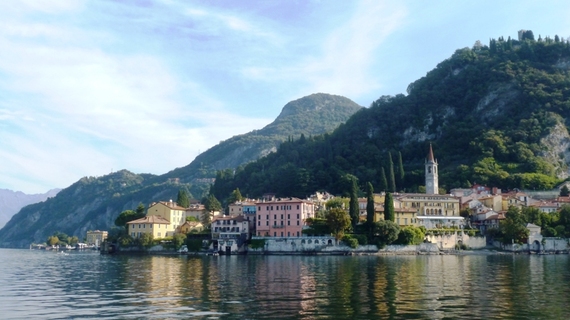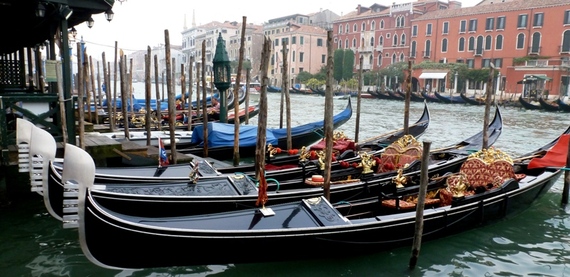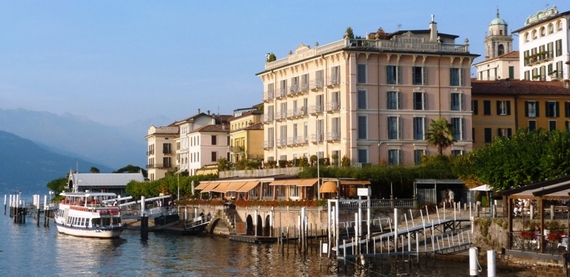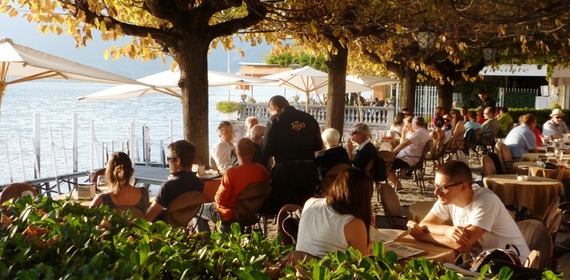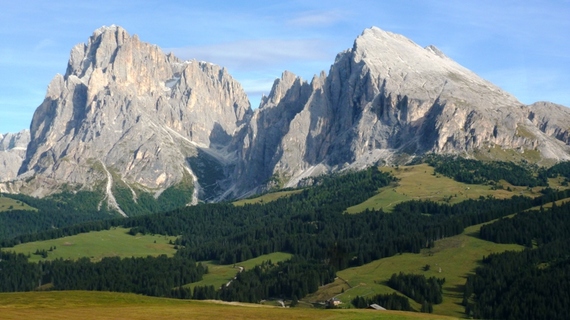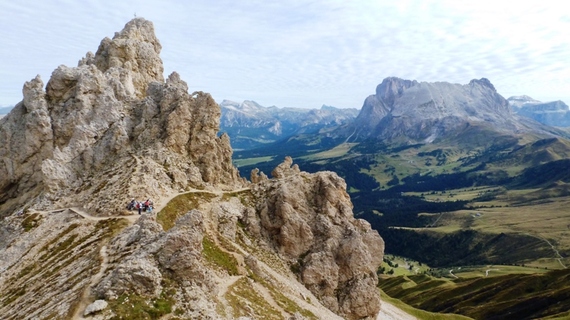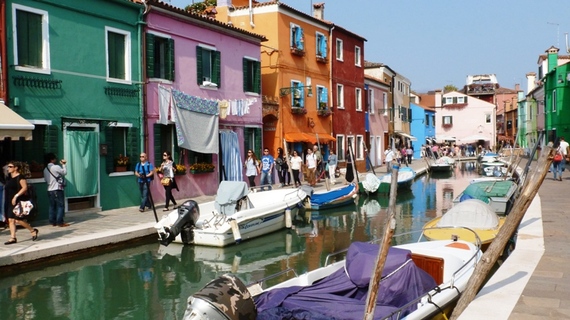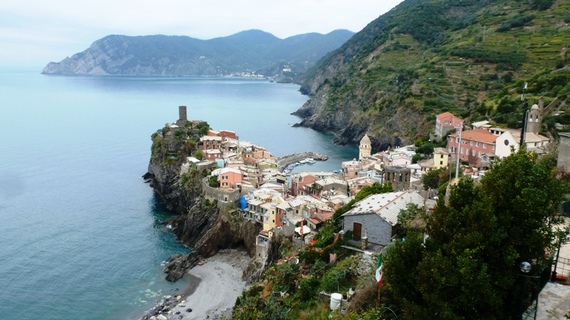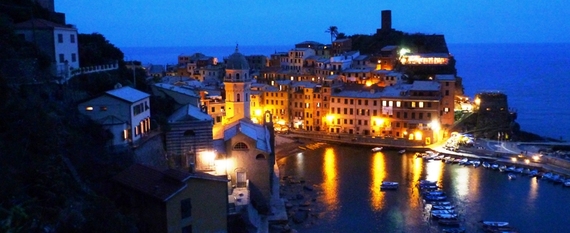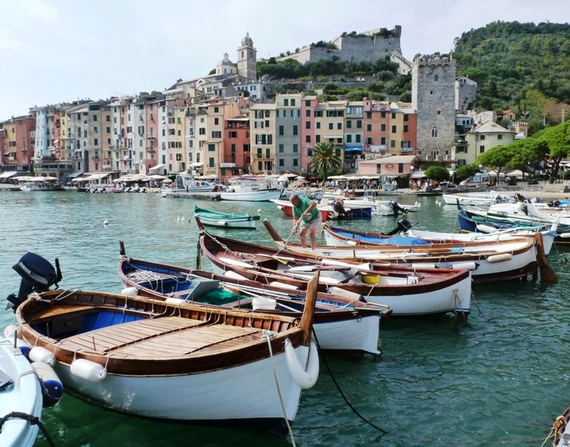The Italians are many wonderful things - but slow, safe and sane drivers, they are not. Italian highways resemble race tracks more than roads, and cars can be expensive and a hassle in the country's ancient, pedestrian-oriented cities.
The solution is to tour Italy by train. All the grand stops of Northern Italy are 2-3 hours apart by rail. Italian train cars are efficient and comfortable and many seats come with tables and power outlets so you can catch up on emails as you zip through the countryside. You can even bring your own bottle of wine on board and enjoy a glass. There's no need for a Eurail pass; it's far cheaper to just buy tickets as you go. Ticket machines are in English and easy to understand.
Italian rail stations are always near the center of the city and surrounded by hotels - usually the best bargain hotels too. Travel light and you can easily roll bags from the station to the hotel, traveling for instance from Venice to Florence in three hours, hotel door to hotel door, with maybe even a nap on the train in between.
The country is set up ideally to tour clockwise, spending two nights in each of the classic stops of Lake Como, the Dolomites (Italian Alps), Venice, Florence, Cinque Terra, and Milan.
So here then is the grand tour of classic Northern Italy by train, arriving and departing from Milan.
Bellagio & Lake Como
If it's good enough for resident George Clooney and to be used as a location for the James Bond film Casino Royal, then Bellagio, the "Pearl of the Lake," is a perfect first stop in Italy. You'll have to take a train from the airport to Milan central station, and then catch a second train to Varenna, a picturesque lakeside village with tree-shaded cafes. It's a relaxing place to sip a glass of wine while you wait for the ferry and the 30 minute sail across Lake Como to Bellagio.
Arriving by water into Bellagio's harbor is one of the great romantic moments of Italy. The harborside is lined with cafes, manicured trees, shaded walks, and Old World elegant hotels, while the lakeshore in all directions is rimmed by far off mountains.
The town is small, but ritzy, and filled with covered arcades housing expensive and exclusive boutiques and upscale restaurants, mixed in with the usual tourist shops and pizza places.
On your free day in Bellagio, take the "slow" boat up the lake, stopping at villages along the way for a lakeside lunch and stroll, or a tour one of the famed historic villas like Villa Carlotta or the 18th Century Villa del Balbianello, used as a film set in Star Wars: Episode II, of all things.
Bolzano, The Dolomites and The Italian Alps
You'll have to ferry from Bellagio back to Varenna or sail south on the lake to Lecco and catch an hour train back to Milan. From here, it's an easy train ride to Bolzano, the gateway to the jagged and dramatic rock mountains that make up the Italian Alps. These are possibly the most beautiful and photographed mountains in Europe. Entering Bolzano is like leaving Italy and entering Germany; the small city is completely German in appearance, language and food because it was part of Austria before World War I.
This is the one spot you may consider renting a car for a day to drive the high twisting roads through mountain passes, though it is just as easy and cheaper to take a 40-minute public bus ride to the cable-car at Siusi. Here, you are whisked up high above the trees into the mountains to Alpe di Siusi - Europe's largest high-alpine meadow.
This is calendar country, filled with grass-covered rolling hills dotted with farmer's huts and tranquil cows with bells. The horizon in all directions is a rocky panorama of snow covered mountains. You can do easy, level hikes across the meadows, or take chair lifts even higher to access trails that cut literally through the mountains. Get a good map at the information center. The trails are well marked, and all trails heading downhill will eventually take you to an outdoor café with delicious ice-cold German beers on tap. Still, you are in a high mountain meadow accessible only by cable car, so you don't want to miss the last ride down.
Venice
With a change in Verona, it's just three hours by train from Bolzano to Venice. Exiting the train station, your first view of Venice is a magnificent scene of chaos overlooking the Grand Canal where every type of watercraft can be seen sailing by. Everything in Venice moves by water -- police boats, ambulance boats, and garbage boats float along as do expensive yachts and barges filled with everything from beer and food to construction materials.
You'll move by water too, on vaporettos, the sleek, cool black ferries that ply the canals and connect the many islands of Venice. Buy a daily pass so you never have to hesitate whether to hop on board.
Venice can be crowded beyond imagination, especially when cruise ships are in. It's hot, dirty, expensive, exhausting and confusing. It's also quite possibly the most wonderful city on the planet.
There are a hundred guidebooks to the sights, but truly, the most amazing experience in Venice is just to wander and get lost in the maze of ancient twisting streets, alleys and canals.
At night, when the cruise ships depart, the back streets of Venice are almost deserted. The most romantic ride in the city is the hour long "slow" vaporetto, which sails up the Grand Canal, pulling into every stop while all the lights of the city reflect in the water. Most people heading back to the train station board the night vaporettos at Piazza San Marco, at which point the ferries can become hopelessly crowded. To avoid the crowds, just walk east along the waterfront two stops and board the ferry here. At this point, you'll have the vaporetto to yourself and can get the choice seats in the bow. Bring your own bottle of wine and glasses and you can have a drink on the one hour ride up the canal.
Florence
The loveliest Renaissance city in the world is just three hours by train from Venice. Almost all the major sites are within a twenty minute walk of the train station. Make your first stop the central Visitor Information Center and ask what museums are free that day. Several times a week, a different museum remains open at night with free admission. The day we visited, there was an hour wait and $12 charge to see Michelangelo's famous sculpture David during normal hours, but it was free that evening and we walked right up to it alone at 9 p.m.
Florence is another city to stroll - and climb. It's 463 steps to the top of the Gothic cathedral, the Duomo, but worth it for the central view over the red rooftops of the city. Likewise, it's a long climb to Piazzle Michelangelo, a pleasant park on top of a hill on the other side of the river, but in late afternoon, the view from the café over the entire city and countryside is stunning.
While the city is filled with museums, there are also dozens of free sites to explore, from Ponte Vecchio, the city's most famous bridge, which is lined with gold and silver shops, to the popular and picturesque markets of San Lorenzo and Mercato Centrale. It's free to enter the courtyard of Palazzo Vecchio, a palace dating to 1540, and every street in the city is lined with statues, art and history. Make sure you bring an extra camera battery.
The Cinque Terre
The last stop, a few hours by train from Florence, has no museums or famous historic sites. It is just an untouched, car-free, section of the Italian Riviera. The rugged, hilly coastline is a mixture of rock cliffs and vineyards and is dotted with five incredibly beautiful and remote seaside villages. The towns are connected only by ferry, by train or by hiking paths. Hiking from village to village is one of the principal pastimes, always rewarded on arrival by a café stop for a glass of wine or a local beer. There are beaches and sun, wildflowers and cliffs, and wondrous coastal views, many of them from brightly colored cafes perched on rocky promontories overlooking the harbor. Ferries can take you south around the coast on a scenic 40 minute trip to perhaps the most gorgeous town of all, Portovenere, this one capped by an ancient fortress.
Each of the five towns has its own personality...and fans. For me, Vernazza was the most dramatically situated and offered the best feel of a real Italian town. No mistake, the Cinque Terre is not undiscovered, and by day it can be packed with tourists and hikers. But hotels are limited (most people make arrangements to stay in private houses through booking services).
In the evening, Vernazza and the other towns revert to small Italian villages. Laundry hangs from the windows, residents chit-chat on the streets, dogs run along the small harbor, and everyone sips a glass of wine to celebrate and toast the setting sun.
From Vernazza, it's just three hours by train to Milan.
If you go: As with any trip to Europe, the best guide is Rick Steves. His books are worth the investment in money (and the weight of carrying them around).
